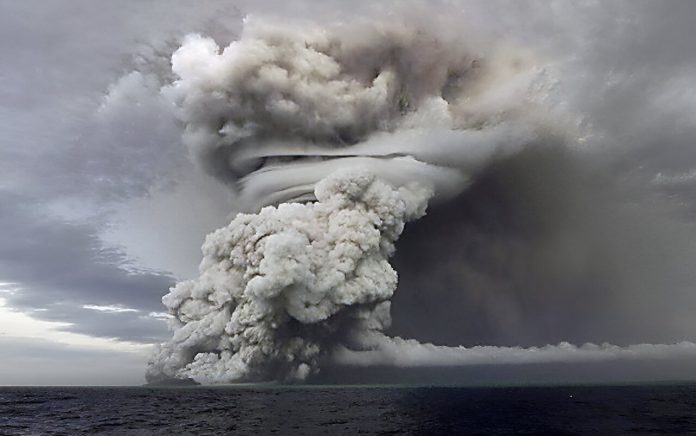
A new study by a team of researchers, including Texas A&M University’s Dr. Andrew Dessler, examines the 2022 eruption of the Hunga Tonga volcano and its impact on the climate.
The eruption, which occurred in mid-January 2022, released a massive amount of volcanic aerosols and water vapor into the atmosphere.
Traditionally, big volcanic eruptions like those of Tambora in 1815 and Mt. Pinatubo in 1991 have cooled the Earth by blocking sunlight with their aerosols.
However, the Hunga Tonga eruption was different.
As an underwater volcano, it released an unprecedented amount of water vapor into the stratosphere, increasing the stratospheric water content by about 10%.
Since water vapor is a powerful greenhouse gas, some scientists initially thought this might explain the extreme global warmth seen in 2023 and 2024.
Contrary to these initial thoughts, the new study, published on July 24 in the Journal of Geophysical Research: Atmospheres, shows the opposite.
The eruption actually contributed to cooling the Earth, much like other major volcanic events.
The team’s paper, “Evolution of the Climate Forcing During the Two Years after the Hunga Tonga-Hunga Ha’apai Eruption,” includes insights from Dessler and first author Dr. Mark Schoeberl, along with scientists from NASA.
They analyzed satellite data from NASA and the National Oceanic and Atmospheric Administration (NOAA), focusing on aerosols, water vapor, and other factors to estimate the Earth’s energy balance.
Their findings revealed that the eruption resulted in more energy leaving the Earth’s climate system than entering it, causing a slight cooling effect.
“Our research disproves the idea that the eruption caused the extreme warmth of 2023 and 2024,” Dessler explained. “Instead, we should focus on greenhouse gases from human activities as the main cause of the warming, with help from the ongoing El Niño.”
This study has important implications. By dismissing the volcanic eruption as a major factor in recent warming, it emphasizes that human-induced greenhouse gas emissions are the primary drivers of climate change.
This is especially important in light of ongoing debates and misinformation about the causes of global warming.
Schoeberl also stressed the need for continued investment in satellite-based stratospheric measurements. “Our understanding of the Hunga Tonga eruption is thanks to the investment in stratospheric satellite measurements by NOAA and NASA over the past two decades,” he said.
“However, we need to be cautious about a potential ‘stratospheric data desert’ as some of the most critical instruments are not being replaced.”
While this study answers many questions, it also raises new ones. For example, the researchers noted unresolved issues like the surprisingly low levels of sulfur dioxide from the eruption and its minimal impact on the 2023 ozone hole over Antarctica.
Additionally, the persistence of water vapor in the stratosphere beyond what was predicted suggests there is still much to learn about stratospheric processes.
As scientists continue to explore these questions, the team’s work underscores the need for ongoing research and precise data to tackle the challenges of climate change.



